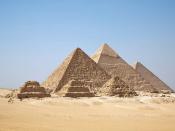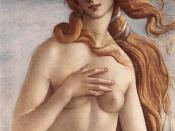Civilizations from antiquity lacked the wonder of science to explain the world; the forces of nature on earth, the fates of peoples lives, the spirits of the dead. However, they still needed to turn to something to try and explain these phenomena, so they began to create stories about mysticism and deities. These stories evolved into legends and myths that crossed cultures between Greece and Egypt over time and created gods and goddesses to whom they assigned different duties. The duties of the creation of the universe and the beings in it fell primarily on the goddesses for they were the fertile sex from which life could be brought forth. The major creation goddesses for the Egyptians are Hathor whose responsibilities the Greeks placed upon Aphrodite and Hera, Neith whose duties became those of Athena, Artemis, and Gaia, and finally Nut, who shared her essence with the three generations of Greek creation goddesses: Gaia, Rhea, and Hera.
Hathor, the Golden One was the goddess of love and when she is compared with Golden Aphrodite and Hera of the Golden Throne it is evident that, although they originated in two different cultures, they were similar in appearance and responsibilities. Hathor, whose name means "feminine power", was the "chief of all the goddesses, divine mother of the king of Egypt, and the special deity of women" (Lesko 82). Hera parallels her by being Zeus' wife and Queen among the gods. Hathor was important to the men in Egypt as well as the women, and people from both sexes vied for the priestly positions in temples dedicated to Hathor, which were found everywhere in the world that Egyptians were located. Votive offerings left by ordinary men and women show that Hathor is the goddess that presides over fertility, human sexuality, love, and a...


